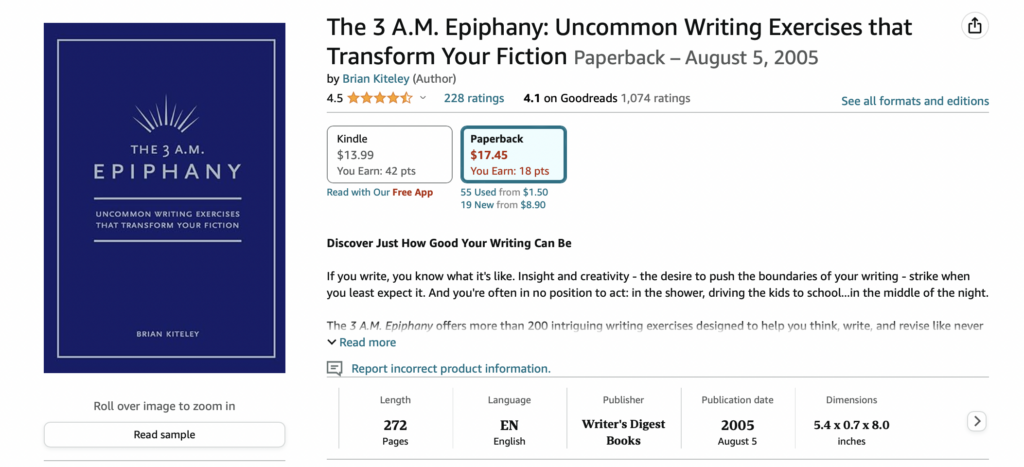AFFILIATE MARKETING
11 Important Steps in 2023

Having your name on the cover of a book is a dream come true for most people. They want the increase in authority that being an author grants them, but they don’t know where or how to start writing. This is particularly true if you have little to no experience writing or formatting your thoughts into words. You need to know how to write a book with no experience, moving from concept to completion.
If you are ready to do some of your own writing and put your skills to good use, here are 11 easy steps you can follow to make the writing process move smoother.
Familiarize Yourself with the Writing Process
Before you can start writing, take some time to familiarize yourself with the writing process.
This might mean researching different outlining techniques (more on this soon) or learning how to walk through every step of the publishing process.
Preparation can help your first draft move along more quickly and easily with less time in the editing stages.
Research is the most important thing to you at this stage of the process.
No matter what your question may be, you can learn how to write a book with no experience simply by dedicating a few hours to learning more about the world of traditional publishing and self-publishing.
It sets you up for increased success as a writer when you understand the ins and outs of a writing process.
Choose a Profitable Topic

How much money can you make by embracing a writing journey? Well, it really depends on how many people want to buy your book.
Choosing a profitable topic and book idea allows you to write a book specifically for the market.
Tools like KDSPY can help you find profitable niches and keywords that appeal to your desired target audience. KDSPY allows you to research what your competitors are doing and what keywords are really moving books right now. It even helps you estimate revenue for your new titles.
For more information on whether this tool is right for you, check out our KDSPY review here.
Hone Your Writing Skills (Books and Exercises)

Maybe you want to know how to write a book with no experience but feel overwhelmed by all of the things that you need to learn and do to be a successful writer.
It all starts with something simple: honing your writing skills and flexing that creative muscle.
Invest in a few quality books of writing prompts to give you an endless number of ideas for where you can take your next project. You never know — you might even write a book based on one of these prompts!
Here are some of my favorite writing prompt books that teach technique and get you thinking:
Before you write a book, you might want to start with a short story. Use some of these writing prompts to kickstart your ideas and help you move forward.
Outline Your Book Before You Start Writing

Maybe you feel prepared to start writing now that you have some ideas flowing, a little bit of character development going on, and a story structure in place.
I’m not sure if there ever is such a thing as being totally and completely ready to write a book. However, you can go far if you do some planning before you sit down to start the book. In other words, you should plan and outline your new book idea.
Here are two methods that you can use for novel writing, short stories, or even non-fiction writing.
Pixar Method of Storytelling
Pixar is arguably one of the most well-known storytellers in the world. They have a simple structure for how their stories are formatted that all writers can benefit from.
If you’ll be writing a book of fiction, then you’ll want to try out this method. It looks something like this:
- Once upon a time…
- Every day…
- One day…
- Because of that…
- Because of that… (repeat until you get to the next step.)
- Until finally…
Fill out all of the sentences with the details of your story idea. This helps you frame the beginning of the story and marry the plot and purpose together, avoiding major plot holes in your story. This is just a way to think about story structure with a fresh perspective.
Outlining Non-Fiction Writing
Things are a little different if you want to write a non-fiction book instead of science fiction, fantasy, or another fiction genre. You can try a different type of writing exercise to learn how to write a book with no experience in this genre.
Think about these aspects of your book as you plan:
- Title and subtitle: It should be clear what your book is about and how it will help readers engage with the text.
- Format: Understand how you want to structure the book, whether that is by short chapters, sections, interviews, or some other creative format.
- One sentence synopsis: Write a single sentence that captures what each chapter or section will be about.
- Connection to the reader: Write a sentence or two about the changes that will take place in the reader from the time they start your book to the time they close the book.
Start Writing a First Draft

With a little planning accomplished, it’s time to start writing your first draft. The writing process may feel challenging when you’re working on a first draft, but this will hopefully fade for you with time.
Set aside a specific amount of time to write each day so that you are guaranteed to get some work done.
If you write a page a day, you will have a 365-page book at the end of the year. Writing just this much a day is an achievable goal as you hone your writing skills.
Keep in mind that a first draft is meant to be sloppy and unrefined. At this point, the goal is not to polish your prose but to simply get the words on the page. If you go over each word with a fine-toothed comb right now, you will never finish writing the book.
Make progress and watch the pages stack up. Editing comes later.
Seek Out Community for the Writing Journey

The writing process is slow-going, and it can even feel quite lonely at times. After all, the process of writing forces you to sit by yourself and work with nothing but your own thoughts and feelings.
No matter what type of writing you do (fiction or non-fiction), everyone can benefit from having friends alongside them.
A writing community or a writing group can give you crucial feedback that you need to improve your manuscript. It provides a safe container for you to practice writing and see what areas you might need to shore up.
They may even be able to offer you resources to learn new skills.
Of course, choosing a group that fits your writing style is the best way to become a better writer. Don’t sign up for a group that has all non-fiction authors if you’re writing fiction.
You might even want to find a group that specializes in your genre. For example, everyone might be working on a romance novel or a science fiction book.

Maybe you worry that you aren’t a good writer, or you struggle to stay focused on writing a book that your audience would love to read.
If you find yourself stressed by how many words you need to write, and it hinders you from doing any actual writing, it might be time to call in the reinforcements.
AI tools are making it easier than ever before to write an entire book. They can help you create compelling characters, develop plots, and get a first draft done as soon as possible with minimal hands-on time for you.
Jasper is one of the top tools if you want to start writing but have trouble getting started. You can use it as a jumping-off point by having it write an introduction to each chapter or allow it to write the book on its own.
With the right guidance, it can also help with character development. It can be modified by tweaking the inputs that you give the tool.
However, you will need to have some of the work done before Jasper can do the heavy lifting. An outline will help you guide the tool and shape what it gives you until you get something that matches your expectations.
For more guidance on how to use Jasper, see our complete Jasper review here.
Edit the Entire Book

Hopefully, the book will flow from your fingertips with ease once you start writing. Once the draft is done, you start to really think about what it needs in order to be in publishable shape.
Especially if you are trying to learn how to write a book with no experience, you might want to consider hiring a professional editor to give it a once-over.
There are multiple kinds of editors, so decide what might suit you best:
- Developmental editors: These editors look for plot holes and story structure. They look at the bigger picture of your book to make sure everything hangs together.
- Copy editors: This type of editor looks for grammar and syntax issues so that your sentences don’t draw too much attention to themselves.
- Proofreaders: Proofreaders look for small errors like typos.
Of course, you can also hire a writing coach to help you along the path to publishing.
A writing coach is someone who can help hold you accountable for putting words on the page. They might also serve as a sort of first-line developmental editor.
Oftentimes, they can pinpoint problems with your story before it gets too far along.
Put Your Book into the World with Self-Publishing

The fastest and easiest way to get your book into the hands of readers is through self-publishing. Particularly if you are interested in how to write a book with no experience, this is the easiest way to make it past the gatekeepers of a traditional publishing company.
Traditional publishing involves submitting your story to an agent who sells it to an editor who brings it to completion. Self-publishing allows you to cut out the middleman and keep more royalties in your pocket.
Amazon’s Kindle Direct Publishing allows you to upload your manuscript and publish it as an ebook, paperback book, or hardcover book without investing thousands of dollars.
They take a cut for the print-on-demand service, but it is a hands-off way for you to manage your overall book sales.
The downside to publishing this way is that you may not have the same valuable insights that you would receive from an in-house editor.
If you have no prior experience, this can mean the difference between writing a book that people will love to read and one that falls flat.
Final Thoughts: How to Write a Book with No Experience
Are you ready to dive into how to write a book with no experience? The most important thing you can do to move the needle forward on your dreams of becoming a published author is simply to start writing as soon as possible.
Spend some time learning about the craft of writing, researching the topics that are selling in today’s marketplace, and outlining your book idea.
With some of these frameworks in place, you’ll be able to write a book you can be proud of!
For more information on how to write a book, see some of our other guides here:
AFFILIATE MARKETING
AI Marketing vs. Human Expertise: Who Wins the Battle and Who Wins the War?

Opinions expressed by Entrepreneur contributors are their own.
Uncover the truth about AI in marketing and why it’s a ticking time bomb for unprepared businesses! As AI revolutionizes the marketing landscape, understanding its long-term impact is crucial.
In this video, I dive deep into the reality of AI marketing, exposing the myths and revealing strategies to stay ahead of the curve. Learn why AI might play in your favor for the next 3 years, but could spell trouble if you’re not prepared for what’s coming. Discover how to leverage AI tools effectively while developing a future-sighted approach that will keep you competitive in an AI-driven world.
Download the free ‘AI Success Kit‘ (limited time only). And you’ll also get a free chapter from Ben’s brand new book, ‘The Wolf is at The Door – How to Survive and Thrive in an AI-Driven World.’
AFFILIATE MARKETING
5 Financial Blind Spots That Could Be Preventing You From Making More Money

Opinions expressed by Entrepreneur contributors are their own.
Money can often be the barrier between being stuck where you are or breaking through to the next level. This includes having or not having a budget, using it properly, hidden revenue or even misaligned goals — all of which influence your growth trajectory. These four common secrets have helped my company elevate our clients to the next level.
1. Financial transparency for ROI
The first blindspot we often notice with new clients is not having a clear reporting connection between your tools, like ads and a CRM like HubSpot, to see which channels drive the most significant return on investment (ROI). Do you know your best-performing channels? Or your best-performing piece of sales copy? What is the most opened document that leads to a closed deal?
And we’re not just talking about marketing and sales; this applies to many connected platforms — for example, the closed-loop revenue or your ERP systems. When things are not connected, they are disjointed and siloed. You end up flying blind. Without connecting your marketing tools with your revenue tools, and with that being CRMs, finance platforms, or ERPs, to name a few, there is a disconnect, and the arms and legs end up moving in different directions.
Here’s a simple example we see all the time: If you knew that one channel drove more deals by a 75% faster conversion rate, wouldn’t you invest more time and energy in that channel than one that only had a conversion rate of 10%? Many people don’t want to share the revenue numbers within the company, but all of that information informs the other departments; without sharing these revenue numbers, your money secret is keeping it in hidden silos.
2. Strategic investment for avoiding blind spots
Another financial blindspot is not investing in marketing. We have had prospects come in with no budget and no internal marketing team, but we want to grow by 150% and spend a total of $1,000. I wish achieving growth like this was possible, but unfortunately, it’s not. The old adage that you get what you pay for, or it takes money to make money, speaks the truth. Your investment goals should match your growth goals. The amount of money invested should be measured not just by short-term, quick wins but also by looking at long-term investment to growth.
You would never measure an HR department strictly on the number of hires. However, looking at the whole picture of longevity amongst many other important KPIs, You would not use an HR department for a few months. It is something that is constant and needs care and attention. Marketing is no different — if you strictly only measure marketing by the number of leads, you are missing out on the full picture. Marketing helps push leads through nurture campaigns, creates automation, leads scoring, builds new campaigns and tests, supports sales enablement activities and many other components. A buying cycle is rarely a straight line to click and buy unless we’re discussing Amazon.
That said, everyone has budgets, margins and bumper lanes they need to stay in. I am by no means saying throw your budget to the wind, but your goal should match your budget. If you have modest growth goals, be realistic about the budget needed to get there. Set incremental micro goals but stay the course for long-term growth.
Related: You Won’t Have a Strong Budget Until You Follow These 5 Tips
3. Data-driven decisions to save money
Another money secret that costs companies is spending without the data to back it. We had a company inquire about a new website, a full blow-up, new navigation, new content, new page layouts, migration onto a new CMS, a new theme and the works. They said they had a $75,000 budget for the whole project. In theory, it sounds great, right? Willing to invest? Check. Has a budget? Check. Know what they want the end result to be? Check. But when we asked them the next question, they looked at us like we were crazy, “Do you have data that backs the changes you are looking to make?” Are you running a tool like Hotjar to see real user data behind how these proposed changes will impact your existing inquiries and the only source the sales team was currently using for leads?
The answer was no. When the heat map was overlaid, do you know what happened? Well, they were looking to build that new navigation out and replace the old one — nearly 90% of the traffic was going to two pages of their site directly from the navigation, both of which they had originally wanted to remove. In this case, it wasn’t just about having the money but also about making sure the decisions you make with the budget are informed by real data: user data, sales data, marketing data and more. The more informed you can be by closing the loop on your data, the better your end result will be.
Related: Want to Be Better at Decision Making? Here are 5 Steps to Better Data-Driven Business Decisions
4. Modern marketing channels to drive growth
What is likely costing you the most is using old-school channels without the ability to measure. Companies have spent the last decade on traditional marketing channels and are switching to digital. The company’s historical growth has relied on things like trade shows, print, postcards and online magazines. We ask what the ROI you have seen by each channel is, and rarely can they share a specific revenue number and say it is for brand awareness. Some of the budgets can be over 50 to 100 thousand dollars spent on these traditional methods, but there is no ROI attached, yet they continue them.
When the pandemic happened, we saw a massive influx in businesses shifting from once only boots on the ground to digital. The lockdown changed everything; there were no more trade shows, no more door knocking and no one picking up their mail or faxes daily. It made traditional selling channels challenging and obsolete and forced a new level of openness to try new ways to get the job done. In the example of running online magazine ads there are lots of ways to capture them, we can use UTM tracking, referral analysis or create a custom landing page for the offer and capture the leads directly. Without running them to a landing page or form, you rely only on the online publication for leads and analytics. We’ve had people show a list of just names, no emails to follow up with, or only show a random number of visitors to the page, not a single name. It’s important to know what they will provide for reporting and tracking when you publish or use traditional channels. The rule of thumb is to use connections and tools that leverage old-school methods into technology and not blindly spend on channels that cannot be measured.
Stop wasting time, energy and revenue on these blind spots. They have easy solutions, so you can avoid them and focus on growing your business!
AFFILIATE MARKETING
How Nvidia Pivoted From Graphics Card Maker to AI Chip Giant

A decade ago, Nvidia was a major graphics card maker, vying with competitors like AMD and Intel for dominance. Now it’s an AI giant with 70% to 95% of the market share for AI chips, and the brains of OpenAI’s ChatGPT. It’s also the best-performing stock with the highest return in the past 25 years.
Why did Nvidia invest in AI chips over 10 years ago, ahead of the competition? CEO Jensen Huang and board member Mark Stevens, Nvidia’s two largest individual shareholders, talked to Sequoia Capital partner Roelof Botha to explain what Botha called “one of the most remarkable business pivots in history.”
Nvidia’s original product was 3D graphics cards for PC games, but company leaders noticed by the mid-2000s that the PC market was hitting a growth limit.
“We felt we were always gonna be boxed into the PC gaming market and always knocking heads with Intel if we didn’t develop a brand new market that nobody else was in,” Stevens explained.
Jensen Huang, co-founder and chief executive officer of Nvidia. Photographer: Lionel Ng/Bloomberg via Getty Images
That need for a new market intersected with a product Nvidia already had on hand: its graphics processor unit, or GPU, which could be used to power tasks outside of gaming. Researchers at universities across the world began exploring the graphics cards, eventually building advanced computers with them.
Related: Is It Too Late to Buy Nvidia? Former Morgan Stanley Strategist Says ‘Buy High, Sell Higher.’
Huang recalled meeting a quantum chemist in Taiwan who showed him a closet with a “giant array” of Nvidia’s GPUs on its shelves; house fans were rotating to keep the system cool.
“He said, ‘I built my own personal supercomputer.’ And he said to me that because of our work… he’s able to do his work in his lifetime,” Huang said.
Other researchers, like Meta AI chief Yann LeCun in New York, began reaching out to Nvidia about the computing power of its chips. Nvidia began considering the AI market when AI had yet to enter the mainstream and was a “zero billion dollar market” or a market that had yet to materialize.
“There was no guarantee that AI would ever really emerge because, keep in mind, AI had had many stops and starts over the last 40 years,” Stevens said. “I mean, AI has been around as a computer science concept for decades. But it had never really taken off as a huge market opportunity.”
Huang and other company leaders still believed in AI and decided to invest billions in the tech in the 2010s.
“This was a giant pivot for our company,” Huang said. “The company’s focus was steered away from its core business.”
Huang highlighted the extra cost, talent, and skills Nvidia had to account for with the pivot, as it affected the entire company. It took 10 to 15 years of effort, but that business decision led to Nvidia powering the AI revolution with an early ChatGPT partnership.
“Every CEO’s job is supposed to look around corners,” Huang said. “You want to be the person who believes the company can achieve more than the company believes it can.”
Related: How to Be a Billionaire By 25, According to a College Dropout Turned CEO Worth $1.6 Billion
-

 SEARCHENGINES6 days ago
SEARCHENGINES6 days agoBillions Of Google goo.gl URLs To 404 In The Future
-
SEARCHENGINES5 days ago
Daily Search Forum Recap: July 22, 2024
-

 SEARCHENGINES7 days ago
SEARCHENGINES7 days agoGoogle Core Update Coming, Ranking Volatility, Bye Search Notes, AI Overviews, Ads & More
-

 SEO6 days ago
SEO6 days ago11 Copyscape Alternatives To Check Plagiarism
-

 SEO6 days ago
SEO6 days agoGoogle Warns Of Last Chance To Export Notes Search Data
-
SEARCHENGINES4 days ago
Daily Search Forum Recap: July 23, 2024
-

 AFFILIATE MARKETING6 days ago
AFFILIATE MARKETING6 days agoThe Top 5 AI Tools That Can Revolutionize Your Workflow and Boost Productivity
-

 SEO4 days ago
SEO4 days agoSystem Builders – How AI Changes The Work Of SEO















